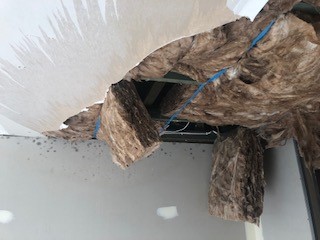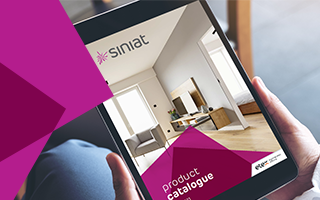There are various ways in which plasterboard can get wet. It may be due to direct contact with water, such as flooding or a leak, or condensation forming on the surface of the plasterboard.
Plasterboard can also become wet due to conditions where it will absorb large amounts of moisture from the air. This can include constant high humidity caused by environmental conditions, or possibly from standing water close by, combined with poor ventilation.
Whatever the cause, left for a period of time moisture can damage the plasterboard and result in costly repairs.
How does moisture affect plasterboard?
When plasterboard is exposed to elevated levels of moisture for an extended period, it may affect the integrity of the plasterboard and its ability to perform its intended function. Plasterboard acts like a sponge and can absorb a large amount of moisture. This can lead to sagging, bulging and discolouration of the board and turn it into the perfect breeding ground for unsightly and unhealthy mould.
Usually the paint on the surface of the drywall will protect it against small leaks and spilled water, but the problem occurs when the water gets to areas that are not protected by paint, such as the back of the plasterboard and at the floor or ceiling.
Plasterboard that has become wet during its service life must be assessed for damage and then either repaired or replaced.
In all circumstances it is recommended to ask a plasterer for a professional evaluation of the water damage, who will be able to advise if repair or replacement is required. Siniat always recommend replacing the affected area if any doubt exists regarding the integrity of the installation.
Also read our blog Getting back in shape after flood damage.
First things first
When there is active flooding in a building, always make safety the first priority. First turn off all electricity to avoid the risk of electric shock.
Identifying and removing the source of water or moisture is the next step in addressing the problem. The earlier the source of water or moisture is found and removed, the better the chance that the integrity of the plasterboard will be maintained.
It is recommended to remove water from ceilings by drilling a hole to let accumulated water escape, but take care: A sagging or saturated ceiling may collapse and temporary props are recommended.
When plasterboard has been exposed to moisture, there is always the risk of mould. Given the right circumstances mould can grow on any surface – including glass! Plasterboard is no exception.
Get it dry
Before an assessment can be made about the integrity of the plasterboard, it must be allowed to dry completely. Wet plasterboard cannot be assessed and reparation work and/or painting should not be undertaken before it has dried.
The affected area must be checked to ensure water is not still present in the wall and ceiling cavities. All insulation should be removed to allow the board to dry out. Insulation that cannot be readily removed, such as in a wall cavity, may prevent the cavity from drying at all.
If condensation has formed on a plasterboard surface or the plasterboard is absorbing moisture from the air, the area must be ventilated to reduce humidity. Fans should be used to generate air flow and increase ventilation.
All windows and doors of the dwelling should be opened to reduce the humidity and speed up drying.
A moisture meter will provide an accurate reading of the moisture content of plasterboard, but a screwdriver poked into the board will also be able to tell you if the board is wet or not. If it’s soft, it’s wet.
Repair or replace?
It is not possible to give a definitive answer on whether plasterboard can be salvaged once it has become wet. It depends on the individual situation and factors such as:
- Extent of time and amount of moisture to which the plasterboard was exposed.
- Ability of the affected area to be identified, completely drained and dried.
- Presence of insulation in the wall or ceiling cavity.
- Whether or not the plasterboard was exposed to contaminated water (such as floodwater that may contain sewage).
Generally, plasterboard may be salvaged if adequate drying conditions are achieved, but if any of the following signs of water damage are present then the plasterboard may lose the ability to perform its intended function and may therefore need replacing:
- Corrosion to steel framing members or fasteners
- Distortion or sagging of the plasterboard
- Swelling or softening of the plasterboard core
- Plasterboard joint distortion
- Plasterboard liner paper delamination
- Fastener popping/pull through
- Adhesive de-bonded from plasterboard or frame
- Excessive mould growth.
- Almost all ceilings that have been inundated with water will need to be replaced, particularly if it’s been in contact with saturated insulation. Water will likely have pooled for a long period and compromised the fixings too.

Plasterboard swells when wet and may pull away from fasteners and remain insecure even after drying. The fixing system used for the plasterboard, including fasteners, adhesive and also the frame, must therefore be inspected and assessed by a professional for damage.
Specialty plasterboards
With fire rated plasterboard and other specialty application products, some or all of the properties can be compromised once the product has been damaged. For these specialty products, Siniat cannot validate performance after any water damage has occurred.
When replacing plasterboard in a fire resistance or sound rated system, care must be taken to ensure that all repairs are consistent with the specific fire or sound rated design initially constructed.
Certain plasterboard products such as Siniat’s Watershield , Trurock and Multishield offer extra protection against moisture in wet areas such as bathrooms and indoor swimming pools. Trurock HD incorporates enhanced impact, water and fire performance, sound insulation properties and has the added benefits of mould resistance.
Download Siniat’s On Board – Assessing Wet Plasterboard for more information and guidelines.
The AWCI Queensland also has more information in their updated plasterboard rectification fact sheet. Download it here.







